We had vacationed in Hawaii several times without once spending a chunk of time in Honolulu. As the largest city in Hawaii, it features the usual metro area traffic congestion, aging infrastructure, and gritty neighborhoods. But a deeper dive reveals that there’s much to love about Honolulu!
During my final review of this post, I realized that it’s pretty long. OK, so it’s really long. If you just want the executive summary, here’s a picture gallery of the Honolulu highlights from our recent month of travel on Oahu.

Bishop Museum 
Iolani Palace 
Waikiki Beach 
Waikiki Aquarium 
Honolulu Museum of Art 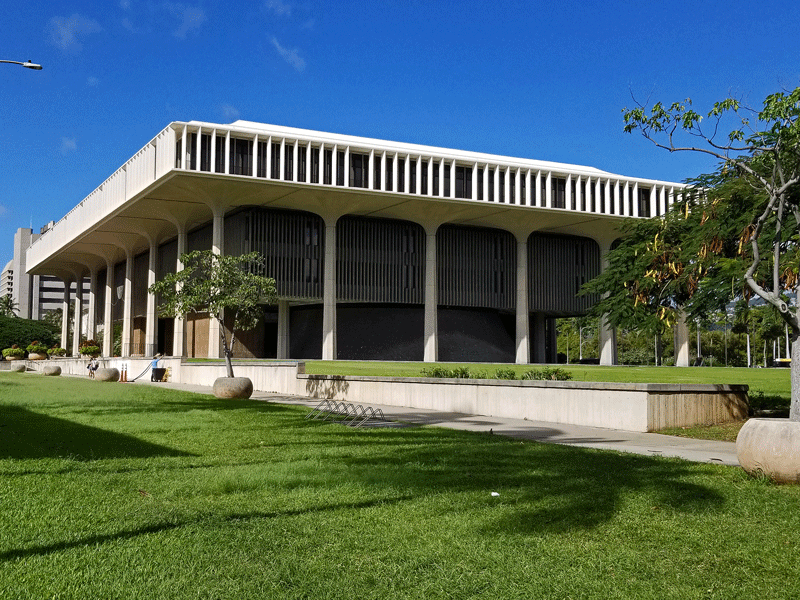
State Capitol Area 
Sony Open Golf Tourney 
Diamond Head Crater Hike 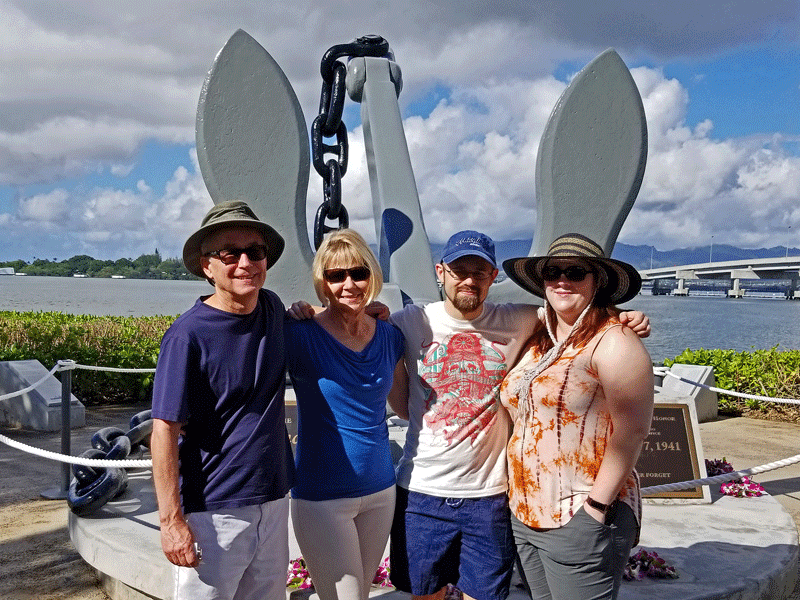
Pearl Harbor Historic Sites
But that’s only nine, right? Keep reading if you want to know what made the #10 spot and to get up close and personal with the first nine!
Bishop Museum
If you are interested in native Hawaiian history and culture, this is the place you need to go! And allow plenty of time – we spent the entire day.
Home to the largest collection of Hawaiian and Pacific cultural artifacts and natural history specimens in the world, this museum was founded in 1889 in honor of Princess Bernice Pauahi Bishop, the last descendant of the Kamehameha royal family.
In addition to the massive Hawaiian Hall packed full of interesting information and articles, the Bishop Museum includes the Pacific Hall, Picture Gallery, Kahili Room, Science Adventure Center, Planetarium, and Science Adventure Center. Plus two special exhibits during our visit – Spineless Wonders (sea creatures) and Surfing in Hawaii.
We thoroughly enjoyed our visit to the Bishop Museum and increased our knowledge and appreciation of Hawaiian history and culture. We were exposed to a vast amount of new information, but I suspect we retained less than 10%. Which, of course, means that we’ll be up for a return visit should we get back to Honolulu.

Bishop Museum street view 
Bishop Museum main exhibit building 
Hawaiian Hall – 3 floors packed with exhibits 
Hale Pili (grass house) used as sleeping quarters 
Murals depicting Hawaiian story of creation part 1: Kumulipo – The Night 
Murals depicting Hawaiian story of creation part 2: Kumulipo – The Day 
Model of Hōkūle‘a, a 20th C. replica of Polynesian double-hulled voyaging canoe 
Eruption of Mauna Loa by Charles Furneaux (1881) 
Surfboard display 
Wooden slit drums from Vanuatu 
Plastic Free Pipeline by Ethan Estess (2019) . . . 
. . . created from marine debris collected off the coast of Hawaii
Iolani Palace
According to the National Park Service, the Iolani Palace (a national historic landmark) in downtown Honolulu is the only royal palace in the United States. Built in a style with both Italian Florentine and Hawaiian architectural elements, it served as the royal palace for King Kalakaua and Queen Kapi‘olani beginning in 1882. After Kalakaua’s death in 1891, his sister, Queen Lili’uokalani, ascended to the throne and reigned until the U.S. government overthrew the Kingdom of Hawaii in 1893.
Between 1893 and 1968, the palace was used for government functions, including a stint as the state capitol after Hawaii became the 50th state. Many of the original palace furnishings were auctioned off, and the building itself fell into disrepair. After the new capitol building opened in 1969, the palace was renovated by non-profit groups, who also made pain-staking efforts to restore the original 19th century decor and furnishings.
The doors reopened in 1978 to the general public. Visitors must book a tour to gain entry, and advance reservations are recommended. We opted for a self-guided audio tour, which took about an hour, and it was superb.
It’s important to mention that 100 years after overthrowing the monarchy, the U.S. government passed a resolution acknowledging that the takeover was unlawful and that the native Hawaiian people never relinquished their claims to sovereignty over their national lands. And so the story continues.

Iolani Palace front view 
Grand staircase in foyer 
Dining room 
Gown worn by Hawaiian royalty 
Gown worn by Hawaiian royalty 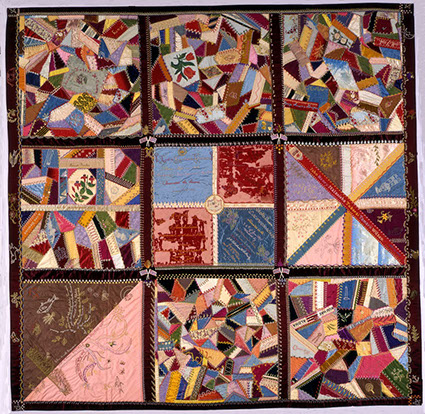
Quilt made by Queen Lili’uokalani during her imprisonment at the palace (Photo credit: quilts.com)

Gown worn by Queen Lili’uokalani – shown in portrait behind the gown 
Throne room

Iolani Barracks, completed in 1871 to house the Royal Guard 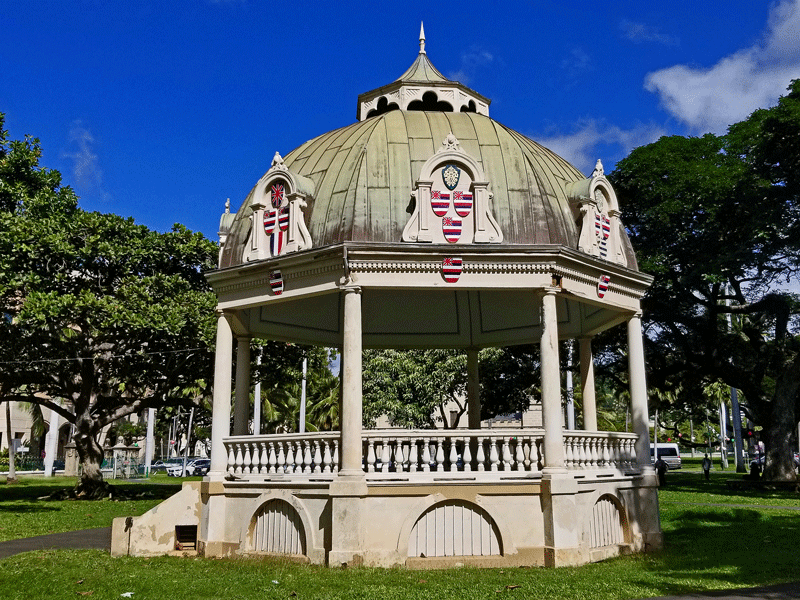
Coronation Pavilion, built for the coronation of King Kalakaua
Waikiki Beach
I suspect that Waikiki Beach needs no introduction. This 2-mile stretch of sand on the south shore of Oahu hosts swimmers, surfers, sun seekers, kayakers, and others who engage in any sort of water activity. Behind the beach is a plethora of hotels, shops, restaurants, and clubs. And lots of people. According to Wikipedia, this vibrant neighborhood generates 42% of the state’s total visitor revenue!
Despite the abundance of commercial development, Waikiki is a beautiful beach and a fun place to visit . . . once or twice. We walked from end to end – once on the beach and once on the street. Saw the sights, did a little people-watching, and found a couple of good places to eat. Add it to your list!

View of Waikiki from the east end 
Diamond Head as seen from Waikiki 
Duke Paoa Kahanamoku Statue (Jan Gordon Fisher, 1990) 
Surfer on a Wave (Robert Pasby, 2003) 
Makua and Kila (Holly Young, 2001) 
Banyan tree on Waikiki


Dinner at Tommy Bahama – Bill, Marlene, Carol, Steve, Gail, Andrew 
Dinner at Appetito Craft Pizza – Steve, Marlene, Carol, Bill
Waikiki Aquarium

We were lukewarm on visiting the aquarium due to a few negative reviews on Trip Advisor (“biggest disappointment of our trip,” “waste of money,” “saw the whole thing in 20 minutes”) but went anyway, since we were spending an entire month to spend on the island. And guess what – we loved it!
Founded in 1904 as a commercial venture, the aquarium has been under the auspices of the University of Hawaii at Manoa since 1919. It’s the second oldest public aquarium in the U.S.
The aquarium’s compact size allowed us to linger at the exhibits rather than rush from one to the next for fear that we would run out of time before we saw it all. We spent a leisurely two hours taking it all in.
As you might expect, the exhibits focus on the animals, plants, and issues pertinent to the Hawaii marine ecosystem.
My favorite exhibit was the coral farm. The Waikiki Aquarium is a pioneer in coral regeneration, having successfully grown and shipped over 5,000 corals to public aquariums and researchers around the world. Branches from existing coral colonies are removed and replanted on special trays, which creates the base for a new colony that grows up to 8″ per year. How cool is that?

Honolulu Museum of Art
The art museum opened its doors in 1927 on 3.2 acres of land in the heart of the city. It’s located in close proximity to the Iolani Palace, the Hawaii State Capitol, and various state and county government buildings.
What a delightful way to spend six hours or so, particularly on a rainy day. The unassuming museum appeared small from the street, but that’s not the case. The original building was designed as a series of galleries surrounding several courtyards, and we soon discovered that every room leads to another, and then another, and so forth. It was a cozy experience – quite unlike other museums that feature grand and cavernous spaces.

Main entrance 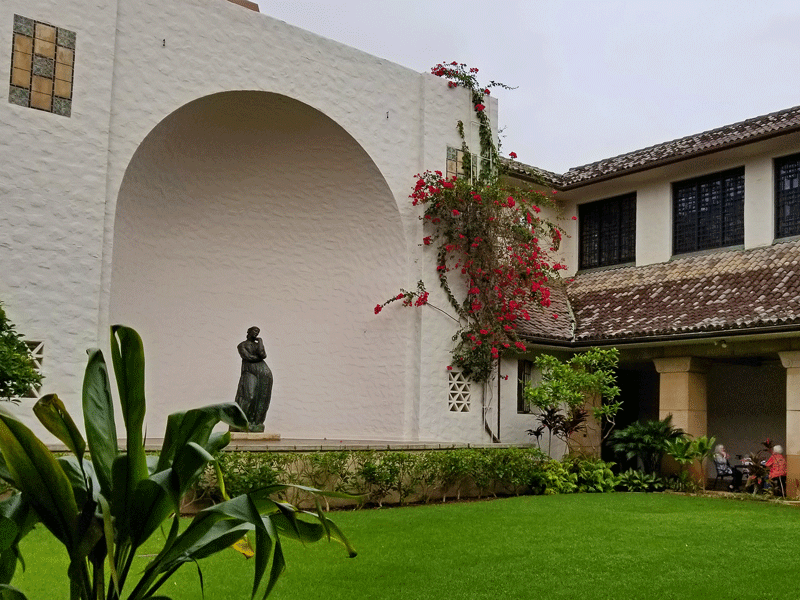
Central courtyard 
Chinese courtyard 
Interesting architecture
The museum’s art collection is interesting and diverse, with galleries dedicated to Hawaiian, American, and European art, as well as exhibits on Africa, ancient Latin America and North America, and the Pacific islands. I spent most of my time, however, in the galleries showcasing Asian art, including exhibits featuring works from Japan, China, Korea, Indonesia, India, and southwest Asia, as well as an exhibit on arts of the Islamic world and a fascinating gallery about Pan-Asian Buddhism.
A day well spent! I hope you enjoy the photos below. One more thing – parking near the museum is scarce. Much easier to call an Uber or ride the bus.

Untitled eruption of Kilauea (Charles Furneaux, 1888) 
Kamehameha III and his sister (Robert Dampier, 1825) 
The Farthest Shore (Melissa Chimera, 2019) 
The Seven Trials of Rustam (Hamid Rahmanian, 2015- Iran) 
Nandi’s Head (India, 18th C.) 
Monumental horse (Indonesia, 19th C.) 
Masks (Bali) 
Untitled (Lee Bontecou, 1964 ) 
Annelies, White Tulips & Anemones (Henri Matisse, 1944) 
Wheat Field (Vincent Van Gogh, 1888)

Tomb sculpture (Japan, late 5th-early 6th C.) 
Guanyin (China, early 11th C.) 
Great Buddha of Universal Illumination (Japan, 10th C.) 
Carved wooden doors (India, 18th C.) 
Chariot paneling (India, 17th C.) 
Three Shiva Ganas (India, 17th C.) 
Totemic vessel with lid (Mayan people, 300-900 A.D.) 
Woman with Gas Mask (Madge Tennent, 1942-45) 
Black Lava Bridge (Georgia O’Keeffe, 1939)
State Capitol Area
We saw the state capitol building on our Google map, and that’s the only reason we knew we were in the vicinity. Not what we expected! I think you’ll agree that nothing about it screams “state capitol.”

In fact, the view from the street was uninspiring, but when we wandered up for a closer look, we were pleasantly surprised. Featuring an open-air design, the central atrium brings in the great outdoors – sun, wind, rain, and even a view of rainbows on occasion.

Completed in 1969, the Capitol houses the executive and legislative functions of state government. The design is uniquely Hawaiian – the building is surrounded by a reflecting pool that symbolizes the Pacific Ocean, the chambers for the Senate and House of Representatives are cone-shaped to symbolize the volcanoes that created the Hawaiian islands, and the exterior columns resemble royal palm trees.
Statues of two prominent historical figures are displayed on the Capitol grounds: Queen Lili’uokalani and Father Damien, the Roman Catholic priest who devoted his life to caring for patients afflicted with Hansen’s disease (leprosy) and eventually died from it himself.

Queen Lili’uokalani 
Saint Damien of Molokai 
King Kamehameha I
The King Kamehameha I statue shown above is located a few blocks away, where it greets visitors to the Hawaii State Supreme Court.
A couple of other noteworthy buildings in the neighborhood are shown below. The first is the final resting place for King William Charles Lunalilo, Hawaii’s sixth monarch.
The second is where we ate lunch – Cafe Julia. This unique restaurant, located inside the YWCA, is named for the architect who designed the “Y” during the 1920s – Julia Morgan, who was concurrently working with William Randolph Hearst on his little weekend cottage, which of course we now refer to as the Hearst Castle.

Lunalilo Mausoleum 
Entrance to Cafe Julia
Sony Open Golf Tournament
Moving on. Bill and I tried to be golf people for ten years – lived on the first hole of a Jack Nicklaus golf course, bought clubs and golfing attire, paid club dues, took lessons, consorted with other golfers, and even played in a couple of benefit tournaments. But it didn’t stick. We eventually sold the house and the clubs and moved on. What stuck with us, however, was an appreciation for watching good golfers.
We didn’t know that our condo in Honolulu was located directly across the street from the 18-hole golf course of the Wai’alae Country Club, which has hosted the tournament now known as the Sony Open since 1965. And we didn’t realize that the annual PGA tour event would take place during the second week of January in 2020.
But we soon found out, due to the hubbub of preparations that began a few days before Christmas and kicked into high gear soon after.

The only question was how much of the tournament we would attend. Ticket prices were reasonable, so Bill and Steve went all four days, while I opted only for the final day.
The entire week was wet and windy, but especially the last day. The rain came down all day, often lightly, but at other times, it was a downpour. The walkways were soggy and sloppy, and we got soaked by the end of the afternoon. (It was, however, 78 degrees, so we were in no danger of hypothermia!)
Our first PGA golf tournament was an interesting experience, and we would go again.
We had good views of the players:
We were reminded to be quiet:

Formally . . . 
. . . and informally
We watched Brendan Steele, leader at the time, birdie a hole halfway through the final round:
Unfortunately, he lost the lead on the final hole, which forced a playoff with Cameron Smith. Smith then prevailed on the first playoff hole and ended the day $1.3 million richer.

Cameron Smith playing from the sand on the 18th hole 
Cameron Smith on the green of the playoff hole 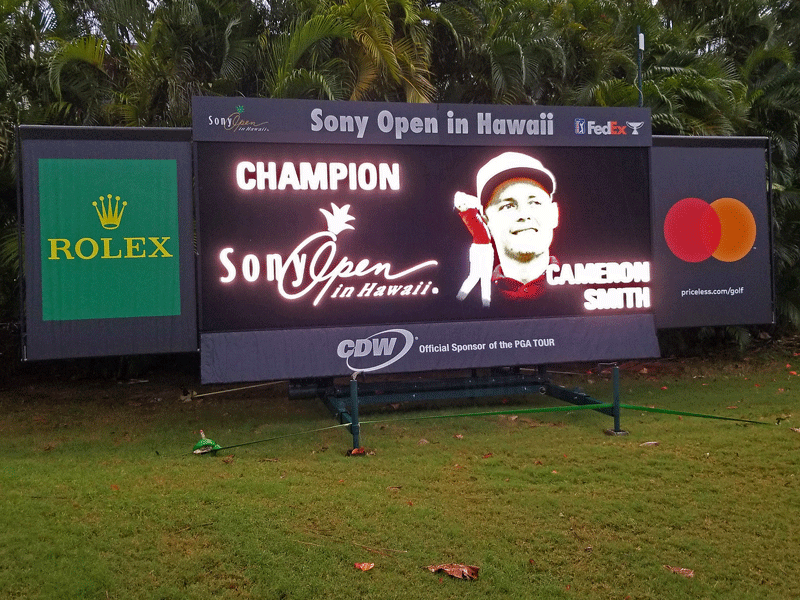

Honolulu Attractions #8 and #9
The Diamond Head summit trail and Pearl Harbor historic sites were fantastic, but since I covered them in a previous blog post, I won’t go there again. You can revisit the photos here: https://followbillandcarol.com/2020/01/07/christmas-week-adventures-in-hawaii/
#10 – The One That Got Away . . .
. . . Shangri-La! But not the fictional Shangri-La mentioned in James Hilton’s 1933 novel Lost Horizon. Rather, I’m referring to Shangri La, the five acres of beachfront property that holds the former mansion of billionaire tobacco heiress Doris Duke – now home to the Shangri La Museum of Islamic Art, Culture & Design.
Shangri La was constructed between 1936 and 1938, and the architecture of both buildings and grounds was inspired by Ms. Duke’s extensive travels in the Middle East, North Africa, and South Asia. She spent the next 50+ years furnishing the space with Islamic art, eventually forming a collection of 4,000 objects.
When Doris Duke died in 1993, she specified that Shangri La and its collections would be owned and managed by the Doris Duke Foundation for Islamic Art. In partnership with the Art Museum of Honolulu, the Shangri La Museum of Islamic Art, Culture & Design began welcoming visitors in 2002.
Doesn’t it look intriguing?

Photo credit: shangrilahawaii.org 
Photo credit: shangrilahawaii.org 
Photo credit: madmuseum.org 
Photo credit: shangrilahawaii.org
Not to mention that Doris Duke herself was an interesting person who experienced life to the fullest. We very much wanted to visit but were unable to secure tour tickets, which we learned the hard way must be purchased well in advance.
Next visit, it will be at the top of our ‘to do’ list!





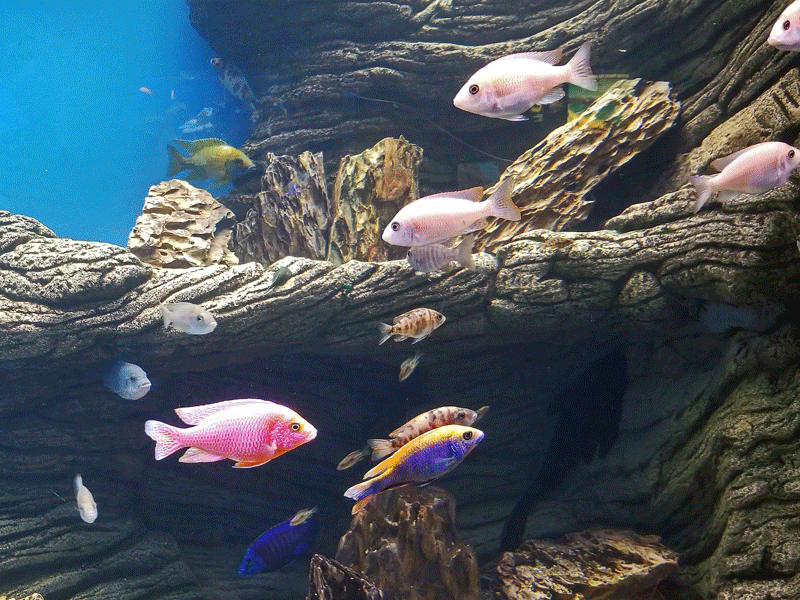


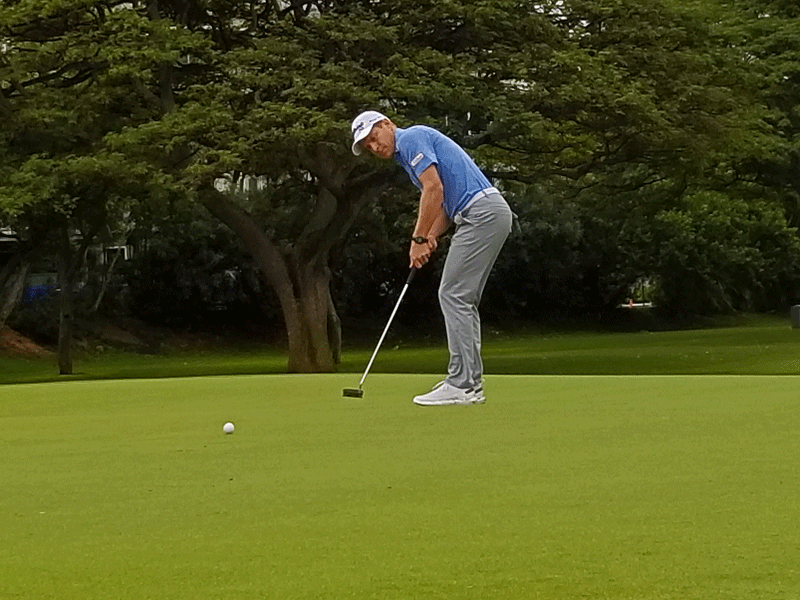


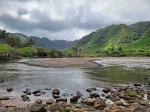
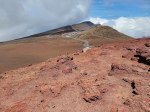

Wow – what an amazing post! I feel like I was there. Such incredible beauty and history. Thank you for the time it took to share this adventure and these Top 10 with us! xo
LikeLike
Hi Mary – thanks for the kind words and for taking the time to read it!
LikeLike
I love your post. It is very informative and well illustrated. A pure fun activity I like on Oahu is taking a glider ride with Honolulu Soaring at Dillingham Airfield. You don’t have to be a pilot. It is amazing.
LikeLike
Thanks for checking it out and for your suggestion. A glider ride sounds like fun! Maybe next time . . .
LikeLike